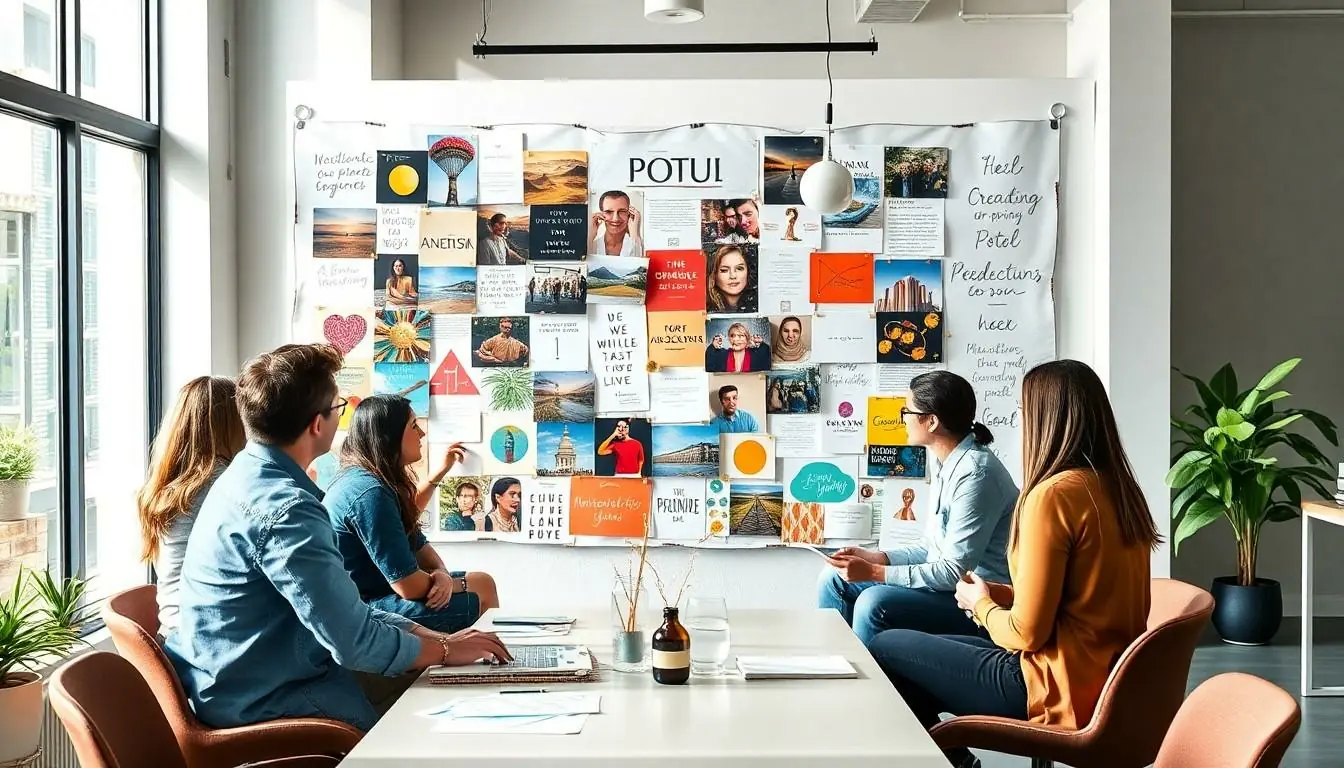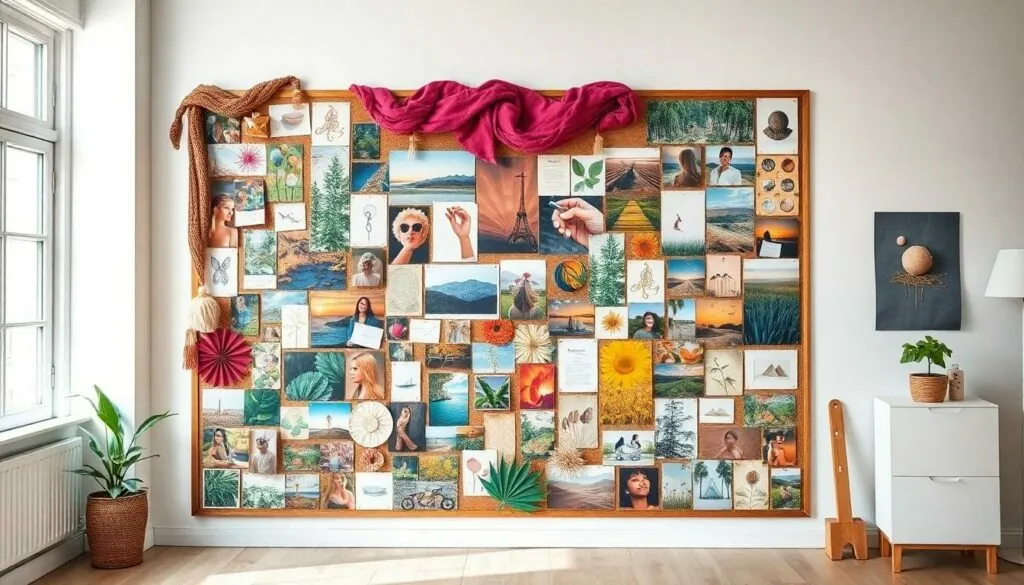In a world overflowing with ideas, finding the spark that ignites creativity can feel like searching for a needle in a haystack. Enter the inspiration board—a magical realm where dreams meet reality and Pinterest boards come to life. Whether you’re an aspiring artist, a seasoned designer, or just someone who needs a little nudge to unleash their inner genius, inspiration boards are your secret weapon.
Table of Contents
ToggleWhat Are Inspiration Boards?
Inspiration boards serve as visual collections that focus on themes, ideas, and aspirations. They utilize images, quotes, and materials to create an engaging layout that stimulates creativity. Individuals from various creative fields use these boards to synthesize concepts and organize thoughts effectively.
Artists often compile photographs, color palettes, and textures to visualize their projects. Designers may gather product samples, typography, and design elements that resonate with their vision. Writers can include images, motivational quotes, and key phrases that inspire their narratives.
The purpose of an inspiration board is to capture the essence of a project. By consolidating visual and textual elements, these boards facilitate brainstorming and provide clarity. Users might find that regular interaction with their boards enhances focus and sparks new ideas.
Creating an inspiration board involves selecting a medium that suits personal preferences. Digital boards using tools like Pinterest allow for easy sharing and updating. Physical boards can include corkboards or canvases that incorporate tangible materials.
Organizing content efficiently enhances the effectiveness of inspiration boards. Categorizing sections for color, style, and theme helps keep ideas structured. Regular revisions ensure the board remains relevant and aligned with evolving creative goals.
Inspiration boards empower individuals to articulate their vision vividly. They function as a personalized compass, guiding creative processes. Users frequently find that these boards not only inspire but also motivate them to take actionable steps toward their goals.
Benefits Of Using Inspiration Boards

Inspiration boards offer numerous advantages, making them essential tools for creativity and project development.
Visual Communication
Visual communication enhances understanding and engagement. Inspiration boards transform abstract ideas into tangible visuals, making it easier to convey messages. Designers and artists use them to showcase themes, colors, and styles, allowing collaborators to grasp concepts more quickly. Clear images and organized layouts lead to effective storytelling, where each piece contributes to the overall vision. Participants can align their thoughts and interpretations without lengthy explanations. Encouraging visual representation enables seamless discussions and fosters creativity by inviting multiple perspectives.
Idea Generation
Idea generation thrives with inspiration boards. These boards encourage brainstorming sessions by providing a canvas for thoughts and concepts. Individuals can collect diverse materials, including images, textures, and quotes, which inspire new ideas. Engaging with varied sources stimulates creativity and prompts innovative solutions. A well-curated board allows users to identify patterns and connections they might overlook otherwise. Effective organization cultivates a focused environment, leading to productive sessions. Embracing this method helps individuals explore their creativity while refining their visions for projects.
Popular Inspiration Board Ideas
Exploring diverse inspiration board ideas fuels creativity and enhances project enjoyment. Different themes and mediums offer unique ways to bring visions to life.
Themed Inspiration Boards
Themed inspiration boards focus on specific concepts, styles, or color palettes. Popular themes include nature, travel, or minimalism. Designers often create boards that reflect specific projects, like home renovations or fashion collections. A well-curated theme provides clarity and helps streamline decision-making. Combining diverse elements that align with a central theme offers inspiration that resonates on multiple levels. Engaging visuals and cohesive design elements draw attention, making the themes even more impactful.
Digital Inspiration Boards
Digital inspiration boards harness technology to organize and share ideas. Tools like Pinterest or Canva enable users to compile images, articles, and videos in one accessible place. Easy collaboration features allow teams to contribute to shared boards seamlessly. Digital platforms often come with search functionalities, making it simple to discover new ideas that inspire. Users can adapt a digital board in real time, ensuring it evolves with creative goals. Additionally, the ability to tag or categorize elements enhances organization and retrieval for future reference.
Physical Inspiration Boards
Physical inspiration boards provide a tactile experience that digital boards can’t match. Corkboards, magnetic boards, and canvas serve as popular materials for creating these boards. Users often print images, cut out articles, and add fabric swatches to enhance the visual appeal. This hands-on approach encourages creativity and promotes interaction with the ideas displayed. Arranging physical elements offers a unique sense of satisfaction and personal touch. Revamping these boards becomes a ritual of creativity, allowing for regular inspiration refreshment.
Tips For Creating Effective Inspiration Boards
Creating inspiration boards involves thoughtful selection and organization of content to maximize effectiveness. Visual impact plays a crucial role in engaging creativity.
Selecting Images and Content
Choose images that resonate emotionally or visually. Opt for visuals reflecting personal style or project essence, such as artwork, photos, and color swatches. Incorporate quotes that inspire or elevate the project’s mood. Strive for diversity in the selected content, aiming for a mix of textures, patterns, and themes. Including materials that evoke a sensory experience can enhance the board’s impact. Regularly revisit and update images to ensure they align with evolving ideas.
Organizing Your Board
Arrange content in a way that tells a cohesive story. Group related images and materials together to create visual pathways. Consider categorizing by themes, colors, or styles for clarity. Use grids or clusters to maintain structure within the chaos of creativity. Tools like digital platforms can assist in resizing or repositioning elements easily, while physical boards benefit from creative layouts that invite exploration. A well-organized board aids focus and inspires creativity, turning ideas into actionable insights.
Embracing inspiration boards can significantly enhance the creative process. They serve as a dynamic tool for individuals to express their vision and refine their ideas. By curating visuals that resonate on a personal level, users can stimulate their creativity and foster a focused environment.
Whether opting for digital or physical formats, the key lies in thoughtful organization and regular updates. This ensures that the board remains a relevant resource that evolves alongside creative aspirations. Ultimately, inspiration boards not only clarify concepts but also motivate individuals to take actionable steps toward achieving their goals.



